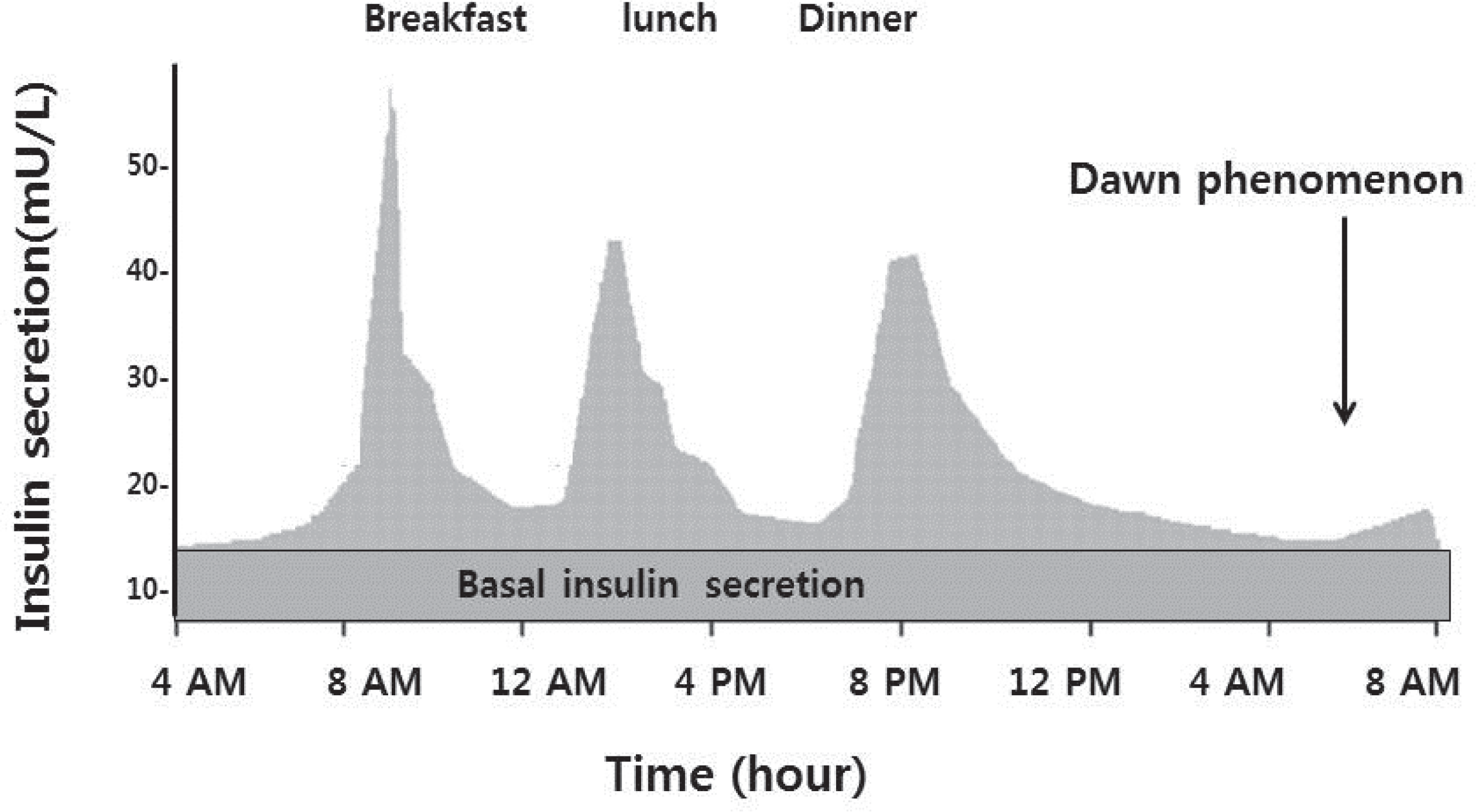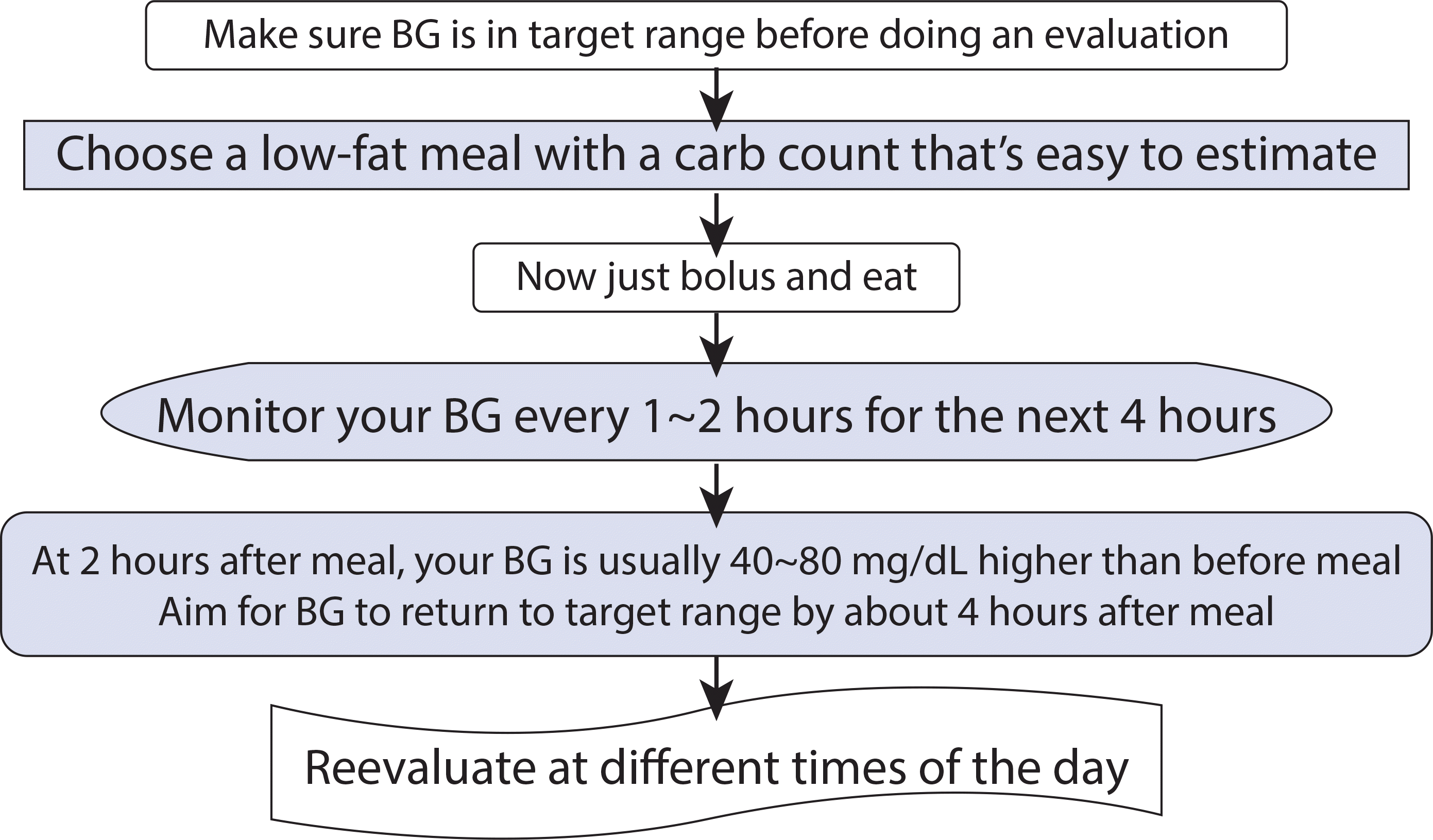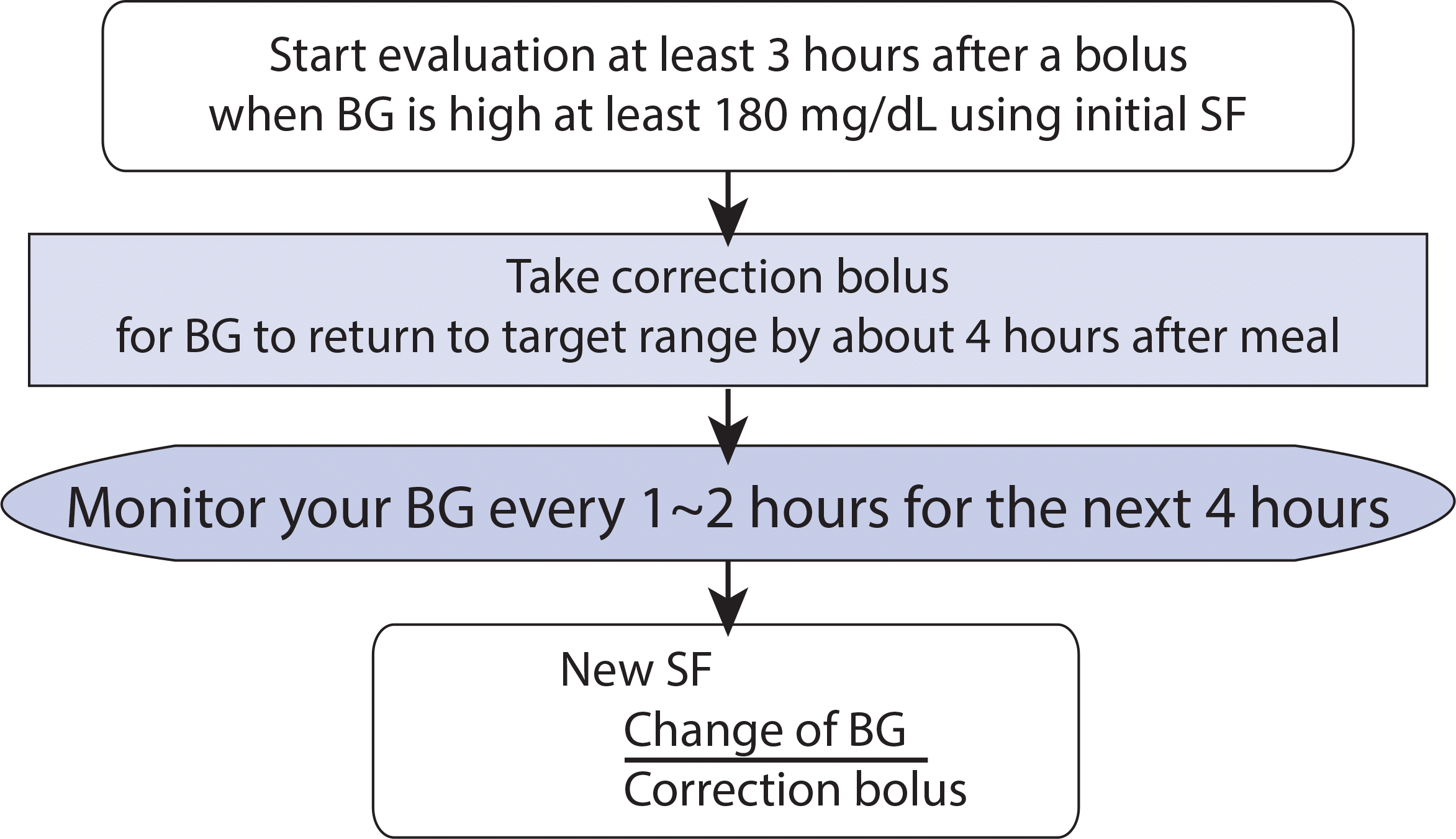Abstract
The Epidemiology of Diabetes Interventions and Complications study, a prospective observational follow-up of the Diabetes Control and Complications Trial cohort, reported persistent benefits for micro- and macro-vascular complication in type 1 diabetes mellitus with intensive insulin therapy. It is the standard of care for most patients with type 1 diabetes. There are two modalities: continuous subcutaneous insulin infusion (CSII), so called insulin pump, and multiple dose of insulin. Both shows similar effects in frequency of severe hypoglycemia and progression of microvascular disease, but CSII provides slightly better in glycemic control. An important aspect of intensive insulin therapy is educating patients about basal insulin, and carbohydrate/insulin ratio, sensitivity index, the coordination of meals, activity, stress, and hormonal changes with frequent monitoring of blood glucose levels during pregnancy. It is important to identify and resolve emotional and attitudinal barriers of the patient and family for improving glycemic control during intensive diabetes management.
References
1. Diabetes Control and Complications Trial (DCCT)/Epidemiology of Diabetes Interventions and Complications (EDIC) Research Group. Lachin JM, White NH, Hainsworth DP, Sun W, Cleary PA, Nathan DM. Effect of intensive diabetes therapy on the progression of diabetic retinopathy in patients with type 1 diabetes: 18 years of follow-up in the DCCT/EDIC. Diabetes. 2015; 64:631–42.
2. Pop-Busui R, Low PA, Waberski BH, Martin CL, Albers JW, Feldman EL, Sommer C, Cleary PA, Lachin JM, Herman WH. DCCT/EDIC Research Group. Effects of prior intensive insulin therapy on cardiac autonomic nervous system function in type 1 diabetes mellitus: the Diabetes Control and Complications Trial/Epidemiology of Diabetes Interventions and Complications study (DCCT/EDIC). Circulation. 2009; 119:2886–93.
3. Scaramuzza AE, Zuccotti GV. Commentary on ‘Continuous subcutaneous insulin infusion (CSII) versus multiple insulin injections for type 1 diabetes mellitus'with a response from the review authors. Evid Based Child Health. 2010; 5:1870–2.
4. Jeitler K, Horvath K, Berghold A, Gratzer TW, Neeser K, Pieber TR, Siebenhofer A. Continuous subcutaneous insulin infusion versus multiple daily insulin injections in patients with diabetes mellitus: systematic review and metaanalysis. Diabetologia. 2008; 51:941–51.

5. Pickup JC, Sutton AJ. Severe hypoglycaemia and glycaemic control in Type 1 diabetes: metaanalysis of multiple daily insulin injections compared with continuous subcutaneous insulin infusion. Diabet Med. 2008; 25:765–74.
6. Fatourechi MM, Kudva YC, Murad MH, Elamin MB, Tabini CC, Montori VM. Clinical review: hypoglycemia with intensive insulin therapy: a systematic review and metaanalyses of randomized trials of continuous subcutaneous insulin infusion versus multiple daily injections. J Clin Endocrinol Metab. 2009; 94:729–40.
7. Yeh HC, Brown TT, Maruthur N, Ranasinghe P, Berger Z, Suh YD, Wilson LM, Haberl EB, Brick J, Bass EB, Golden SH. Comparative effectiveness and safety of methods of insulin delivery and glucose monitoring for diabetes mellitus: a systematic review and metaanalysis. Ann Intern Med. 2012; 157:336–47.
8. Hirsch IB, Bode BW, Garg S, Lane WS, Sussman A, Hu P, Santiago OM, Kolaczynski JW. Insulin Aspart CSII/MDI Comparison Study Group. Continuous subcutaneous insulin infusion (CSII) of insulin aspart versus multiple daily injection of insulin aspart/insulin glargine in type 1 diabetic patients previously treated with CSII. Diabetes Care. 2005; 28:533–8.

9. Bolli GB, Kerr D, Thomas R, Torlone E, Sola-Gazagnes A, Vitacolonna E, Selam JL, Home PD. Comparison of a multiple daily insulin injection regimen (basal once-daily glargine plus mealtime lispro) and continuous subcutaneous insulin infusion (lispro) in type 1 diabetes: a randomized open parallel multicenter study. Diabetes Care. 2009; 32:1170–6.
10. Guilhem I, Balkau B, Lecordier F, Malécot JM, Elbadii S, Leguerrier AM, Poirier JY, Derrien C, Bonnet F. Insulin pump failures are still frequent: a prospective study over 6 years from 2001 to 2007. Diabetologia. 2009; 52:2662–4.
11. Cukierman-Yaffe T, Konvalina N, Cohen O. Key elements for successful intensive insulin pump therapy in individuals with type 1 diabetes. Diabetes Res Clin Pract. 2011; 92:69–73.

12. Cersosimo E. Response to Schade To pump or not to pump? Diabetes Care. 2003; 26:967.
13. King AB, Armstrong DU. A prospective evaluation of insulin dosing recommendations in patients with type 1 diabetes at near normal glucose control: basal dosing. J Diabetes Sci Technol. 2007; 1:36–41.

14. Kuroda A, Kaneto H, Yasuda T, Matsuhisa M, Miyashita K, Fujiki N, Fujisawa K, Yamamoto T, Takahara M, Sakamoto F, Matsuoka TA, Shimomura I. Basal insulin requirement is ∼30% of the total daily insulin dose in type 1 diabetic patients who use the insulin pump. Diabetes Care. 2011; 34:1089–90.

15. Lee HJ, Kim KB, Han KA, Min KW, Kim EJ. Insulin requirement for Korean type 1 diabetics using continuous insulin infusion with portable external pumps. J Korean Diabetes. 2004; 28:538–46.
16. Scheiner G, Boyer BA. Characteristics of basal insulin requirements by age and gender in Type-1 diabetes patients using insulin pump therapy. Diabetes Res Clin Pract. 2005; 69:14–21.

17. El Khoury D, Brown P, Smith G, Berengut S, Panahi S, Kubant R, Anderson GH. Increasing the protein to carbohydrate ratio in yogurts consumed as a snack reduces post-consumption glycemia independent of insulin. Clin Nutr. 2014; 33:29–38.

18. Farrow HA, Rand JS, Morton JM, O'Leary CA, Sunvold GD. Effect of dietary carbohydrate, fat, and protein on postprandial glycemia and energy intake in cats. J Vet Intern Med. 2013; 27:1121–35.

19. Smart CE, Evans M, O'Connell SM, McElduff P, Lopez PE, Jones TW, Davis EA, King BR. Both dietary protein and fat increase postprandial glucose excursions in children with type 1 diabetes, and the effect is additive. Diabetes Care. 2013; 36:3897–902.

20. Klupa T, Benbenek-Klupa T, Matejko B, Mrozinska S, Malecki MT. The impact of a pure protein load on the glucose levels in type 1 diabetes patients treated with insulin pumps. Int J Endocrinol. 2015; 2015:216918.

21. Ma J, Stevens JE, Cukier K, Maddox AF, Wishart JM, Jones KL, Clifton PM, Horowitz M, Rayner CK. Effects of a protein preload on gastric emptying, glycemia, and gut hormones after a carbohydrate meal in diet-controlled type 2 diabetes. Diabetes Care. 2009; 32:1600–2.

22. American Diabetes Association, Standards of medical care in diabetesd-2014. Diabetes Care. 2014; 37:S14.
23. Sasaki S, Yasuda T, Kaneto H, Kuroda A, Fujita Y, Fujisawa K, Tabuchi Y, Kasami R, Matsuoka TA, Matsuhisa M, Shimomura I. Basal insulin requirements after progesterone treatment in a type 1 diabetic pregnant woman. Intern Med. 2013; 52:259–62.

24. Grunberger G, Bailey TS, Cohen AJ, Flood TM, Handelsman Y, Hellman R, Jovanovič L, Moghissi ES, Orzeck EA. AACE Insulin Pump Management Task Force. Statement by the American Association of Clinical Endocrinologists Consensus Panel on insulin pump management. Endocr Pract. 2010; 16:746–62.

25. Cohen O, Keidar N, Simchen M, Weisz B, Dolitsky M, Sivan E. Macrosomia in well controlled CSII treated Type I diabetic pregnancy. Gynecol Endocrinol. 2008; 24:611–3.

Table 1.
Comparison of insulin pump and multiple daily injection
Table 2.
Determination of basal rate




 PDF
PDF ePub
ePub Citation
Citation Print
Print





 XML Download
XML Download